Speech Australian Fixed Income Securities in a Low Rate World
This is my first time at the Debt Capital Markets Summit. I appreciate the opportunity to speak at such an important event in the Australian fixed income calendar.
Over the course of recent months, interest rates on a range of fixed income securities across the globe have risen. Nevertheless, they remain at historically low levels. At the same time, spreads between non-government and government debt have remained low. Indeed, over the past year or so they have declined to be around their lowest levels since the global financial crisis. Accommodative monetary policies and generally low levels of inflation are contributing to easy financial conditions for issuers.
In my presentation today, I'll lay out some of the factors contributing to these financial conditions and then discuss how Australian issuers have responded. In brief, more has been issued, by a more diverse set of issuers at longer average tenors. I'll finish by looking forward to the year ahead.
The Global Story
To tell the story on pricing, for the most part I'm going to focus my attention on spreads between yields on non-government debt and those on government debt. That's a familiar way of thinking about a key part of cost of those funds. At the same time it provides a sense of the market's view of the risks involved.[1]
Globally, spreads on non-government debt are low and they have tightened further over the past year. Indeed, spreads in many markets are as low as they have been since the financial crisis. For corporate bonds that's true of both investment grade and non-investment grade debt (Graph 1). In short, demand for fixed income securities is strong.
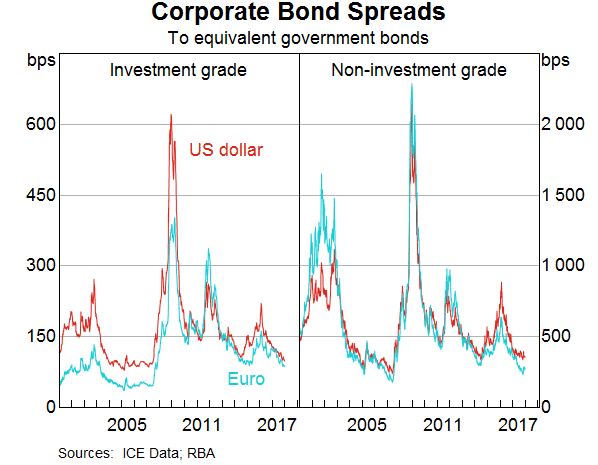
Why might that be? One contributing factor has been the improvement in global economic conditions. This is supporting business profits, which helps to reduce actual and prospective defaults. In turn, this underpins a narrowing of credit premia. We see evidence of this, for example, in the decline in default rates on high-yield US bonds over the past few years, although some of the decline since last year may also reflect the improvement in conditions affecting US oil producers.
Another part of the story may be that uncertainty has declined. This has been most evident in the low levels of financial market volatility observed last year and early this year. That suggests that market participants are more confident about their forecasts of the future. A sense of greater certainty is consistent with the reduction in the variability of many key macroeconomic indicators, which has been accompanied by a decline in revisions to analysts' forecasts of these variables.[2]
Yet another possible reason for the low spreads is that financial market participants appear to be willing to take on risks at lower levels of compensation. In other words, the price of risk may have declined. This could be as a consequence of a few developments. Importantly, accommodative monetary policies have provided investors with an incentive to take more risk so as to achieve a reasonable rate of return. As investors take on more risk, they will tend to bid down its price – as captured by spreads, for example. This is the search for yield that we hear about a lot.
Why Does This Matter for Australia?
So what is the relevance of the decline in spreads on offshore fixed income assets for Australian markets?
First, it matters because many of our corporations issue overseas. This offshore issuance facilitates capital inflows, which are the financial counterpart to Australia's current account deficit.[3]
Most bonds issued by Australian companies are issued offshore, whether they are financial or non-financial companies (Graph 2). For non-financial companies, the influence of mining firms in this market had been significant over recent years. Overseas issuance is quite natural for miners operating in Australia because their revenue streams are often denominated in foreign currencies.
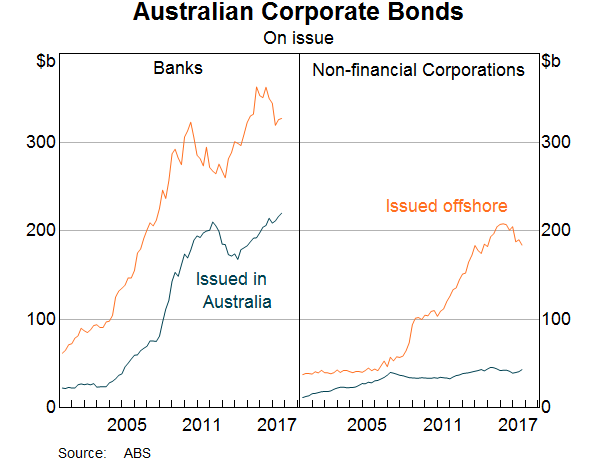
Second, the decline in spreads offshore also matters because they are highly correlated with spreads in the domestic market (Graph 3). For example, spreads on bonds issued by Australian banks in the Australian market have a strong relationship with the spreads faced by US corporations. The same is true for spreads on bonds issued by non-residents in the Australian market (so called ‘Kangaroo bonds’). This should not be that surprising because the market for capital is a global one. If the price of risk in Australia were to deviate too far from the global price – beyond that suggested by any differences in fundamental credit quality – there would be opportunities for profitable arbitrage. One way or another, the process of arbitrage would lead to a degree of convergence between spreads.
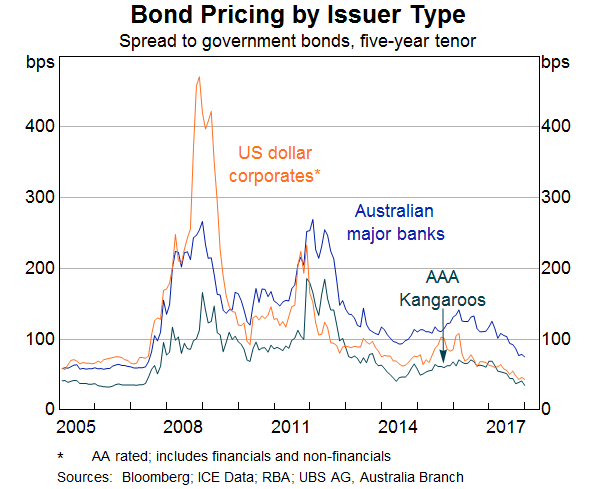
The Response
So spreads have declined in Australia, much like the rest of the world. Is that the end of the story? Far from it. Non-government issuers have responded to these developments in a number of ways.
Low spreads have made it more attractive for companies to issue fixed income securities. Issuance is up across a range of markets. But quantities are not the only part of the story. Good demand conditions have also made it easier for a more diverse range of companies to issue. Moreover, tenor has increased, notably in the domestic market.
Quantities
Let me start with quantities.
Issuance in many markets is up.[4] Gross issuance of bank bonds in 2017 was the second highest since the global financial crisis (Graph 4). In 2016, banks acted ahead of time in preparation for the implementation of the Net Stable Funding Ratio (NSFR) requirement. So, having issued a bit more paper in 2016 than had been the case for some time, it seemed reasonable to have expected that 2017 was going to be a somewhat subdued year for bank bond issuance. As it happened, though, banks took advantage of favourable funding conditions over the past year or so to tap the bond market more actively than might otherwise have been the case.
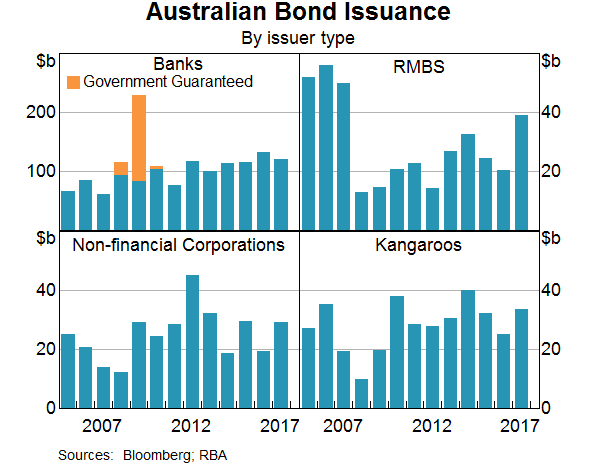
Corporate bond and Kangaroo issuance rebounded from their 2016 levels in 2017, although there have been recent years where issuance was higher.
Issuance of residential mortgage-backed securities (RMBS) was particularly strong in 2017. Indeed, it was the strongest since the global financial crisis. Part of that is likely to have owed to extra issuance by non-banks (i.e. financial institutions that are not authorised deposit taking institutions, or non-ADIs). Their housing lending picked up strongly at the same time as the growth of lending by the major banks was easing. (That in turn reflected the decline in the growth of the major banks' investor and interest-only loans as the banks responded to the Australian Prudential Regulation Authority (APRA) and Australian Securities and Investments Commission's (ASIC) actions to tighten lending standards.) Despite these supply-side motivations, it still appears that demand-side factors were the dominant influence. If the only influence on RMBS spreads had been via increased supply of paper from non-banks to fund their lending, then spreads would have increased. However, spreads have tightened, consistent with a rise in the demand for RMBS.
Diversity
The RMBS market is an important source of funds for mortgages issued by smaller competitors to the major banks. So, it's reasonable to expect that low spreads should encourage some more of those competitors to come to the market. Indeed, that's what we have seen (Graph 5). As a whole, non-major banks (labelled as ‘other ADI’ in the graph) issued $16 billion of securities last year, the highest since 2007. Perhaps more remarkable was the number of ‘other’ (non-major) banks that issued RMBS – by our count it was 17, the highest ever.
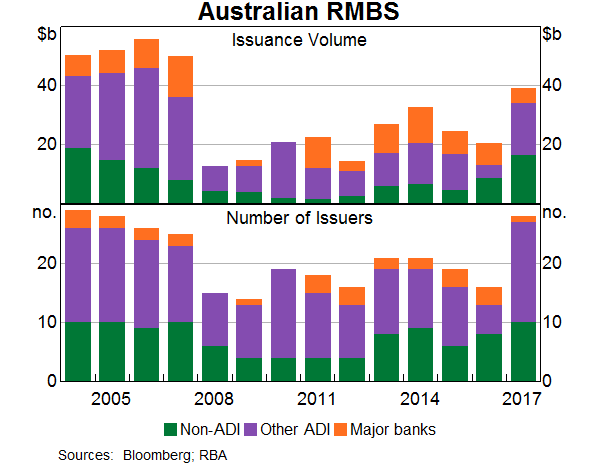
Interestingly, major banks have been relatively inactive in this market. Only 13 per cent of the total volume of issuance in 2017 was accounted for by the majors, the lowest since 2010. One reason the majors have not been more active is that, even with the decline in RMBS spreads, pricing is not particularly attractive for them. Rather, alternative sources of funds – such as unsecured wholesale markets – remain more attractive because spreads in those markets have also narrowed. It's worth noting that many of the other banks, and non-bank securitisers, have rather limited access to long-term wholesale funding, particularly in offshore markets. So they cannot avail themselves of the favourable terms currently on offer there.
An alternative way of showing the increase in diversity is through a Herfindfahl-Hirschman index, which is a standard way of measuring concentration. The lower the index, the lower the level of concentration.[5] There was a sizeable fall in that index in 2017 for RMBS issuers (Graph 6). By this metric, concentration has been falling since 2014, when non-banks issued less than half what they did in 2017 and major banks were far more active in the market.
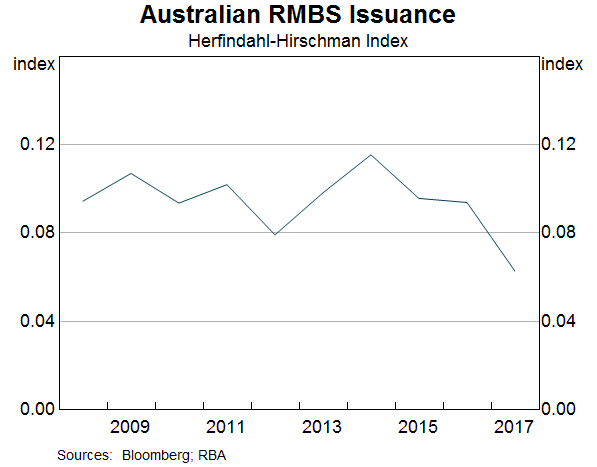
The diversity of issuers has increased in other markets as well. I have made the point in a previous speech that the mining industry is an important part of the Australian corporate debt market.[6] For a number of years following the financial crisis, those companies issued debt to help fund the mining investment boom, although most finance was raised internally.[7] Over the past couple of years, however, resource-related companies have been relatively inactive; some have even bought back bonds as they have sought to reduce their gearing (thereby contributing to the decline in offshore bonds on issuance for non-financial corporations shown in Graph 2). Meanwhile, other companies have stepped up their issuance (Graph 7). In 2017, we saw particularly strong issuance from utility companies. Indeed, combined issuance across non-resource-related sectors was at a record high in 2017. I should note that we would expect issuance to grow in nominal terms as the economy expands. Regardless, it is worth noting that the market is not dominated by resource companies in the way it has been in the past.
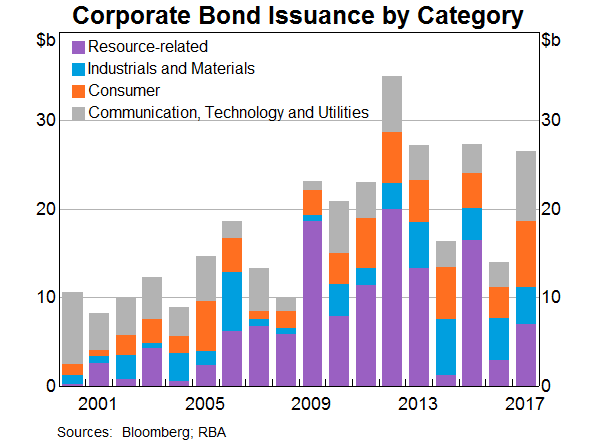
We also have seen a more diverse type of issuer in the Kangaroo market. Again, this is not a story of the past year alone (Graph 8). If we look back 10 years, the Kangaroo market had previously been reliant on financial corporations and European based supranational, sovereign or quasi-sovereign agency entities, known collectively as SSA's. However, as time has passed, we have seen more non-European SSA's enter the market. Also, over the past three years or so, non-financial corporations have begun to issue in the Kangaroo market, such as companies from the United States.
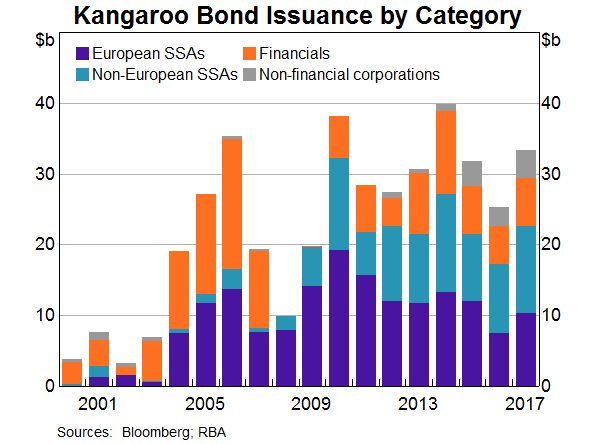
This increase in the variety of the types of issuers in the Kangaroo and non-financial bond markets can also be summarised by Herfindahl indicies (Graph 9). These show a clear decrease in concentration over the past few years, with the indices reaching their lowest levels for some time.
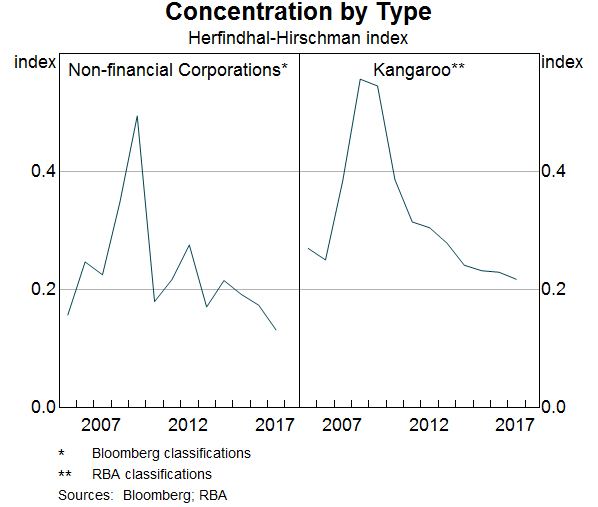
Tenor
Finally, another development worth highlighting is the lengthening in the tenor of issuance in some parts of the market in 2017 (Graph 10). In the case of domestic issuance for non-financial corporations, this increase is part of a longer-running trend, which has been a positive development for domestic markets. Recent increases in average tenor more generally may also be related to the low levels of spreads.
In the case of overseas issuance by Australian banks, 2017 saw some notable deals with quite long tenors. We understand that this lengthening of tenor by the banks has been influenced by market conditions. In particular, banks are taking advantage of the lack of any term premium for longer-term funding. The regulatory environment, particularly the NSFR requirement, may also be contributing to a desire to issue at longer tenors.
You may have noticed that offshore issuance tends to be at longer average tenors than domestic deals. It seems that it is easier, or at least has been in the past, to borrow at term overseas than in the Australian market. By all accounts, Asian investors have helped support longer-term Australian dollar issuance of late.[8] It does not yet seem to be the case that resident investors are able to provide the demand needed for a large volume of longer-term issuance, although that could evolve over time.
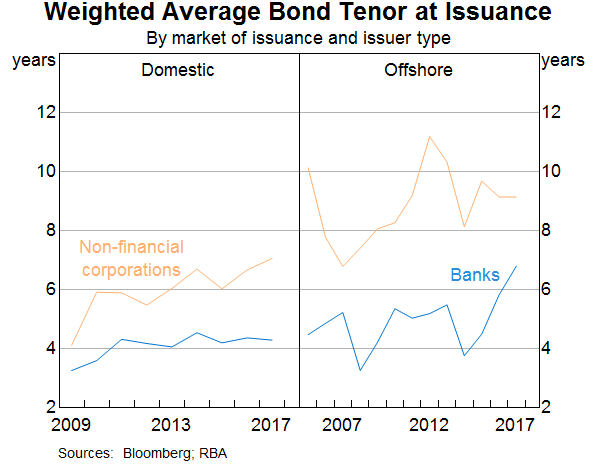
Where to Now?
These developments I've summarised have generally been positive. To recap, accommodative monetary policies and greater confidence in the outlook for global growth have contributed to low spreads on a range of non-government debt. Australian issuers have benefited, with greater issuance, across a more diverse range of issuers and at longer average tenors. But the outlook is not without risks.
Indeed, accommodative monetary policies have encouraged greater risk-taking by both lenders and borrowers. This is one of the important ways in which the monetary transmission mechanism works. It has supported the decline in spreads and other positive developments I've just discussed. At the same time, however, the combination of low interest rates and low volatility in financial markets is of concern to the extent that it can lead to excessive risk-taking via a search for yield. This is something that the Reserve Bank has been noting for a time.[9]
Is there evidence of excessive risk-taking in fixed income markets? It's hard to say. Spreads have been bid down across a range of Australian markets to levels that are close to those that prevailed ahead of the global financial crisis (Graph 11). However, spreads for RMBS are not quite so low relative to that history (Graph 12).[10] First and foremost, this reflects the reassessment at the time of the crisis by investors globally of the risk of this type of asset. That assessment has persisted. Also, it may be that the spread is somewhat higher in Australia than it was a few years ago in response to the build-up of risks in housing markets and household balance sheets – on the back of high and rising household indebtedness. We have talked about that at length for a time now.[11]
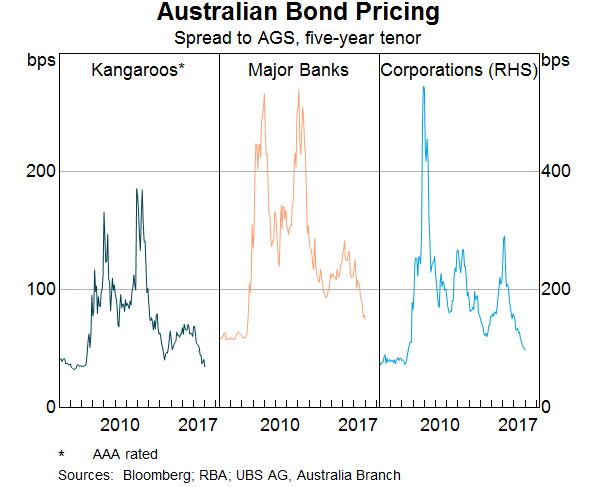
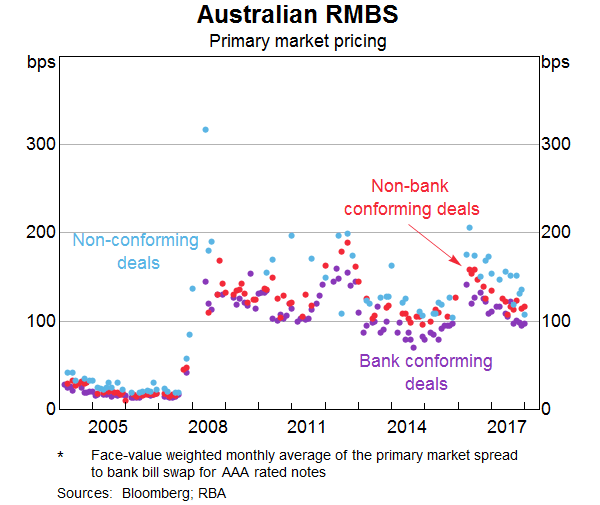
It's not clear that the relatively low level of spreads in fixed income markets represents irrational mispricing of risk or is, by itself, a cause of concern. Issuance has picked up, but it is not especially high. Moreover, measures of corporate indebtedness are generally not elevated (Graph 13). This has been helped by some deleveraging among resource companies, which have been able to reduce the extent of their debt.[12]
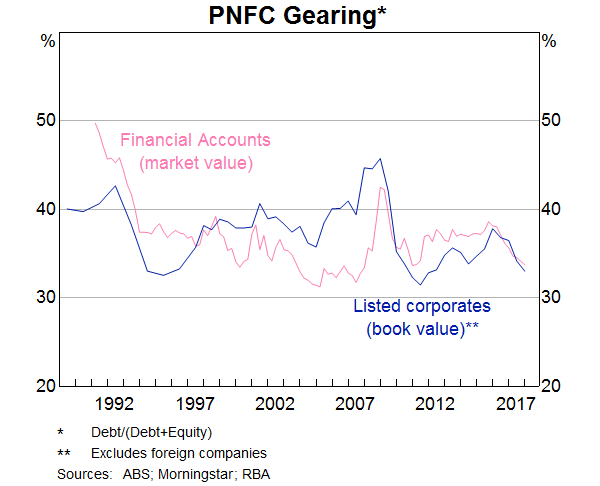
Still, it is possible that we could see a noticeable pick-up in financial market volatility, a sharp re-pricing of assets and, as a result, a tightening in financial conditions, including higher spreads for corporate issuers.
The recent experience in US equity markets has been a stark reminder of that possibility. While US equity markets reacted sharply, and other equity markets around the world responded (though generally to a somewhat lesser extent), the knock-on effect to other markets was modest. In particular, spreads on corporate debt were little changed.
My sense is that this limited response of spreads reflected at least two features of the bout of equity market volatility. First, the sharp response of the US equity market was driven, at least in part, by some sizeable positions that had been taken on the back of an expectation that volatility in that market would remain low.
Second, the equity market turbulence was triggered by a reassessment of the outlook for US inflation and monetary policy. In particular, there was evidence of stronger wages growth and a prospect of rising inflation. It would be appropriate and welcome in that case to see a tightening in financial conditions. If that were to be sustained, it would naturally be accompanied by a reduction in the search for yield and some increase in spreads, which would tend to weigh on issuance. While there's nothing that guarantees that the path of adjustment will be smooth and pain free, the forces that might push the US economy in that direction are not unwelcome in of themselves. And while other advanced economies are further from that point, including in Australia, the expectation is that these same forces will come into play as spare capacity is gradually eaten into and inflation rises.
Thank you for your attention. I look forward to answering questions you might have.
Endnotes
I would like to thank Leon Berkelmans for help in preparing this material. [*]
An important aspect of that is default risk, which I suspect is the thing many people have in mind when I mention risk. However, these spreads will also incorporate liquidity premia – government bonds tend to be quite liquid, and that will also affect their pricing vis-à-vis private sector debt. [1]
For further discussion of this point, see RBA (2018), ‘Box A: The Period of Low Volatility in Financial Markets’, Statement on Monetary Policy, February, pp 25–26. [2]
Debelle G (2017), ‘Recent Trends in Australian Capital Flows’, Address to the Australian Financial Review Banking and Wealth Summit, Sydney, 6 April. [3]
The data in Graph 2 show that the outstanding stock has fallen in overseas markets recently. These data include the effect of issuance and maturities of bonds, as well as exchange rate movements and bond buybacks. [4]
If the market is accounted for by only one player, this index is 1. If, on the other hand, n participants each have an equal share of the market, the index is 1/n. [5]
Kent C (2017), ‘Fixed Income Markets and the Economy’, Address to Bloomberg, Sydney, 9 August. [6]
Arsov I, B Shanahan and T Williams (2013), ‘Funding the Australian Resources Investment Boom’, RBA Bulletin, March, pp 51–61. [7]
For example, see Davidson L (2018), ‘Taking Stock’, KangaNews, Dec 17/Jan 18, pp 12–13. Available at <http: //www.kanganews.com/document/magazines/2017/2017-dec-jan/141-kndecjan17column>. [8]
See, for example, RBA (2017), Financial Stability Review, October. [9]
The RMBS spreads are shown relative to BBSW, which is not a risk-free benchmark. Calculating spreads to Australian Government Securities is difficult given the pre-payment uncertainty of RMBS, nonetheless, when we attempt to do so, we get a similar picture as emerges in Graph 12. [10]
Lowe P (2017), ‘Household Debt, Housing Prices and Resilience’, Address to Economic Society of Australia (QLD) Business Lunch, Brisbane, 4 May. [11]
Kent C (2017), ‘Fixed Income Markets and the Economy’, Address to Bloomberg, Sydney, 9 August. [12]
